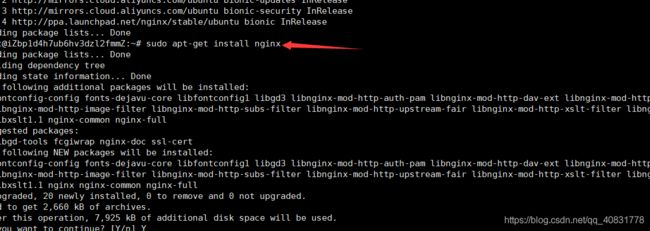flask的web部署云服务器——史上最详细小白教程没有之一
准备工作:
1.阿里云 ubuntu 系统的服务器
2.安装好Xshell软件,如果不会请参照我之前的博客
3.以及自己已经写好的flask的web工程
废话少说,进入正题:
1.首先用Xshell软件连接我们的云服务器
2.更新软件源
键入命令 sudo apt update
键入命令 sudo apt upgrade
3. 设置安全组
4. 部署 Nginx
键入命令 sudo apt-get install software-properties-common
键入命令 sudo add-apt-repository ppa:nginx/stable
键入命令 sudo apt-get update
键入sudo apt-get install nginx
键入命令 nginx -v 查看 nginx的版本
5.运行nginx
键入 sudo /etc/init.d/nginx start
在浏览器输入你的公网ip能看到 下图页面
6.安装python虚拟环境
键入 sudo apt install python-virtualenv
键入 sudo easy_install virtualenvwrapper
创建一个目录用来存放虚拟环境 键入命令 cd .. 在键入 sudo mkdir /flask/root 在键入 cd /flask/root
然后创建项目目录
在 /flask/root/demoapp 文件夹下创建虚拟环境 切换到 /flask/root/demoapp 文件夹下键入 virtualenv -p /usr/bin/python3 py3en
激活虚拟环境 键入source py3env/bin/activate
![]()
安装flask 键入pip install flask
在flask所在路径创建一个hello.py的文件(虚拟环境)
键入 vi hello.py
在hello.py 文件中输入一下代码
from flask import Flask
app = Flask(__name__)
@app.route("/")
def hello():
return "Hello World!"
if __name__ == "__main__":
app.run(host='0.0.0.0', port=8080)书写完成之后,我们按ESC键,键入:wq 退出并保存
键入命令 python hello.py ,在虚拟环境中 执行flask应用
打开 浏览器 搜索 公网ip:8080,就可以看见 hello world
虽然我们已经见到Hello World!字样了,但是此时实际连接的时flask的调试服务器,不能应用在正式工作场合。我们需要使用nginx做反向代理,使用gunicorn作为WSGI。
7.修改nginx配置
为了方便管理,我们把配置文件还是放在/flask/root/demoapp目录下,然后在/etc/nginx/conf.d下做个链接。
键入 vi demoapp_nginx.conf
将下面这段代码编写进去
server {
listen 80;
server_name 公网地址;
charset utf-8;
client_max_body_size 75M;
location / {
proxy_set_header X-Fforwarded-For $proxy_add_x_forwarded_for;
proxy_set_header Host $host;
proxy_set_header Host $host; proxy_pass http://127.0.0.1:8080;
}
}
按esc 键入:wq 保存并退出
将刚建立的配置文件使用符号链接到Nginx配置文件文件夹中,
退出虚拟环境
键入命令 sudo ln -s /flask/root/demoapp/demoapp_nginx.conf /etc/nginx/conf.d
重启Nginx:
键入sudo /etc/init.d/nginx start
8.在虚拟环境中安装gunicorn
Web框架(Flask)致力于如何生成HTML代码,而Web服务器(nginx)用于处理和响应HTTP请求。Web框架和Web服务器之间的通信,需要一套双方都遵守的接口协议。WSGI协议就是用来统一这两者的接口的。
常用的WSGI容器有Gunicorn和uWSGI,但Gunicorn直接用命令启动,不需要编写配置文件,相对uWSGI要容易很多,所以这里我也选择用Gunicorn作为容器。
进入虚拟环境
键入 pip install gunicorn
键入/flask/root/demoapp/py3env/bin/gunicorn -w2 hello:app -b 0.0.0.0:8080
按ctrl+c退出
9.使用supervisor守护gunicorn
同样在虚拟环境中 键入 sudo apt-get install supervisor
键入 echo_supervisord_conf > /etc/supervisor/supervisord.conf
![]()
10.修改/etc/supervisor/supervisord.conf
修改 supervisord.conf 键入 vim /etc/supervisor/supervisord.conf
在文件结尾添加
[include]
files = /flask/root/demoapp/demoapp_supervisor.conf
按键盘字母 i 插入 之后退出并保存
键入 vim /flask/root/demoapp/demoapp_supervisor.conf
将下面代码输入进去
[program:demoapp]
command=/flask/root/demoapp/py3env/bin/gunicorn -w 2 hello:app -b 0.0.0.0:8080 ; the program (relative uses PATH, can take args)
;process_name=%(program_name)s ; process_name expr (default %(program_name)s)
;numprocs=1 ; number of processes copies to start (def 1)
directory=/flask/root/demoapp ; directory to cwd to before exec (def no cwd)
;umask=022 ; umask for process (default None)
;priority=999 ; the relative start priority (default 999)
autostart=true ; start at supervisord start (default: true)
startsecs=10 ; # of secs prog must stay up to be running (def. 1)
startretries=10 ; max # of serial start failures when starting (default 3)
;autorestart=unexpected ; when to restart if exited after running (def: unexpected)
;exitcodes=0,2 ; 'expected' exit codes used with autorestart (default 0,2)
;stopsignal=QUIT ; signal used to kill process (default TERM)
;stopwaitsecs=10 ; max num secs to wait b4 SIGKILL (default 10)
;stopasgroup=false ; send stop signal to the UNIX process group (default false)
;killasgroup=false ; SIGKILL the UNIX process group (def false)
user=root ; setuid to this UNIX account to run the program
;redirect_stderr=true ; redirect proc stderr to stdout (default false)
stdout_logfile=/flask/log/supervisor/supervisor.log ; stdout log path, NONE for none; default AUTO
stdout_logfile_maxbytes=50MB ; max # logfile bytes b4 rotation (default 50MB)
;stdout_logfile_backups=10 ; # of stdout logfile backups (default 10)
;stdout_capture_maxbytes=1MB ; number of bytes in 'capturemode' (default 0)
;stdout_events_enabled=false ; emit events on stdout writes (default false)
stderr_logfile=/flask/log/supervisor/supervisor_err.log ; stderr log path, NONE for none; default AUTO
stderr_logfile_maxbytes=50MB ; max # logfile bytes b4 rotation (default 50MB)
;stderr_logfile_backups=10 ; # of stderr logfile backups (default 10)
;stderr_capture_maxbytes=1MB ; number of bytes in 'capturemode' (default 0)
;stderr_events_enabled=false ; emit events on stderr writes (default false)
;environment=A="1",B="2" ; process environment additions (def no adds)
;serverurl=AUTO ; override serverurl computation (childutils)
编辑完成之后退出并保存
新建supervisor.log文件 ,就新建就行,什么都不用写。 路径看好
新建 supervisor_err.log 文件同上
11.杀掉supervisord,重新启动:
退出虚拟环境 到下图路径
键入pgrep -ax supervisord
键入 kill 14661
键入 supervisord -c /etc/supervisor/supervisord.conf
![]()
键入
supervisorctl -c /etc/supervisor/supervisord.conf status demoapp
12.浏览器搜索地址 你的公网:8080 就会显示 hello world
假如我的 博客有幸帮到了您,您帮忙 麻点个赞,又不花钱,想一同学习的朋友可以关注我一下。
































